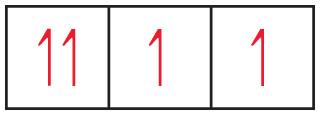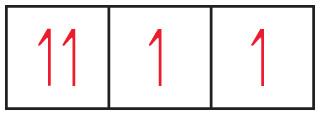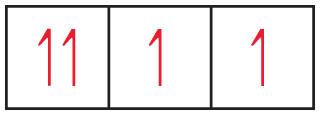Instructions for Side by Side Printing
- Print the notecards
- Fold each page in half along the solid vertical line
- Cut out the notecards by cutting along each horizontal dotted line
- Optional: Glue, tape or staple the ends of each notecard together
Mastering Chemistry End of Chapter 6
front 1 Based on the structure of the periodic table, which becomes occupied first, the 6 s orbital or the 5d orbitals? | back 1 6s |
front 2  As drawn, the drawing is incorrect. Why? | back 2 In the left-most box, the two electrons cannot have the same spin. The Pauli principle states that no two electrons can have the same set of quantum numbers. Since the first three quantum numbers describe an orbital, the fourth quantum number must have different values for two electrons in the same orbital; their "spins" must be opposite. |
front 3  How would you correct the drawing without changing the number of electrons? | back 3 Flip one of the arrows in the left-most box, so that one points up and the other down. |
front 4  To which group in the periodic table does the element belong? | back 4 Group 6A. The drawing shows three boxes or orbitals at the same energy, so it must represent p orbitals. Since some of these p orbitals are partially filled, they must be the valence orbitals of the element. Elements with four valence electrons in their p orbitals belong to group 6A. |
front 5 Which is a statement of Hund's rule? Energy is a minimum when the number of same-spin electrons is maximized. No two electrons in an atom can have the same set of four quantum numbers. The dual nature of matter places a fundamental limitation on how precisely we can know both the location and momentum of an object at a given instant. Mathematical functions called wave functions are used to describe electrons in an atom. | back 5 Energy is a minimum when the number of same-spin electrons is maximized. |
front 6 Which element has the same electron configuration as the nitride ion? 15P 10Ne 4Be 16S | back 6 10Ne |
front 7 State where in the periodic table these elements appear: elements with the valence-shell electron configuration ns2 np5 | back 7 7A |
front 8 State where in the periodic table these elements appear: elements that have three unpaired p electrons | back 8 5A |
front 9 State where in the periodic table these elements appear: an element whose valence electrons are 4s2 4p1 | back 9 Ga |
front 10 State where in the periodic table these elements appear: the d-block elements Groups 1-2 Groups 3-12 Groups 3-8 Lanthanides Actinides | back 10 Groups 3-12 |
front 11 What is the maximum number of electrons that can occupy each of the following subshells? 3p | back 11 6 electrons |
front 12 What is the maximum number of electrons that can occupy each of the following subshells? 5d | back 12 10 electrons |
front 13 What is the maximum number of electrons that can occupy each of the following subshells? 2s | back 13 2 electrons |
front 14 What is the maximum number of electrons that can occupy each of the following subshells? 4f | back 14 14 electrons |
front 15 What is the maximum number of electrons in an atom that can have the following quantum numbers? n=2, ms=-1/2 | back 15 4 electrons |
front 16 What is the maximum number of electrons in an atom that can have the following quantum numbers? n=5, l=3 | back 16 14 electrons |
front 17 What is the maximum number of electrons in an atom that can have the following quantum numbers? n=4, l=3, ml=-3 | back 17 2 electrons |
front 18 What is the maximum number of electrons in an atom that can have the following quantum numbers? n=4, l=0, ml=0 | back 18 2 electrons |
front 19 For each element, count the number of core electrons, valence electrons, and unpaired electrons in the ground state. Carbon | back 19 2, 4, 2 electrons |
front 20 For each element, count the number of core electrons, valence electrons, and unpaired electrons in the ground state. Phosphorus | back 20 10, 5, 3 electrons |
front 21 For each element, count the number of core electrons, valence electrons, and unpaired electrons in the ground state. Neon | back 21 2, 8, 0 electrons |
front 22 Identify the specific element that corresponds to each of the following electron configurations. 1s2 2s2 | back 22 Be |
front 23 Identify the specific element that corresponds to each of the following electron configurations. 1s2 2s2 2p4 | back 23 O |
front 24 Identify the specific element that corresponds to each of the following electron configurations. [Ar] 4s1 3d5 | back 24 Cr |
front 25 Identify the specific element that corresponds to each of the following electron configurations. [Kr] 5s2 4d10 5p4 | back 25 Te |
front 26 The following electron configurations represent excited states. Identify the element, and write its ground-state condensed electron configuration. ls2 2s2 3p2 4p1 | back 26 N |
front 27 Write N ground-state condensed electron configuration. | back 27 [He]2s^22p^3 |
front 28 The following electron configurations represent excited states. Identify the element, and write its ground-state condensed electron configuration. [Ar] 3d10 4s1 4p4 5s1 | back 28 Se |
front 29 Write Se ground-state condensed electron configuration. | back 29 [Ar]4s^23d^104p^4 |
front 30 The following electron configurations represent excited states. Identify the element, and write its ground-state condensed electron configuration. [Kr] 4d6 5s2 5p1 | back 30 Rh |
front 31 Write Rh ground-state condensed electron configuration. | back 31 [Kr]5s^14d^8 |